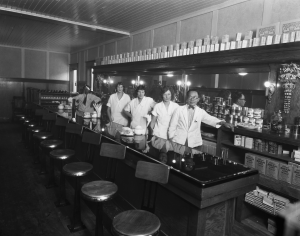Nathalie Cooke and Shelley Boyd

Canadian Cafe & Chop Suey, located at 238 – 8th Avenue SE, Calgary, Alberta, 1973. Photograph by Bill Simpkins. Reproduced with permission from the Glenbow Archives (NA-5516-10b).
This chapter identifies a growing body of Canadian literary works depicting Chinese restaurants as sites and sources of narrative, and seeks to answer a series of questions. What are the characteristics of the genre of restaurant literature? What are the key texts—those responsible for shaping, reshaping, and innovating this genre? What historical contexts have influenced this genre’s development? This chapter looks closely at a representative selection of restaurant literature in order to explore ways in which authors have written Chinese restaurants into the literary landscape, and to understand storytelling’s ability to introduce readers to new characters, cultures, and perspectives over time. It distinguishes between two different bodies of literature in Canada, first addressing a group of works written by those outside the Chinese community in Canada, and then addressing another group of texts written largely by those within the Chinese Canadian community.
Renowned literary critic Sandra Gilbert argues that food is a topic of overwhelming and widespread interest in the twentieth and twenty-first centuries and that a better understanding of this phenomenon will unlock insights about our world. “Our recipe novels and poems,” she wrote in 2014, “our food polemics and cooking programs represent a gastronomical feeding frenzy that’s both unprecedented and deeply significant” (7-8). Food in literature fuels narrative development as much as it feeds literary characters. One only has to remember the various culinary mishaps in Anne of Green Gables, for example, or the doll-shaped cake Marian consumes in the conclusion of Margaret Atwood’s The Edible Woman. In A Feast of Words, literary critic Anna Shapiro focuses her study on fictions in which, were the food not present, the stories would be “broken-backed, useless, with a critical link in the plot key to the character missing” (17). Food is also a remarkably effective tool for a writer. Fiction writer Carol Shields explains that food scenes provide opportunities for refining the depiction of characters and their place and moment in time (45).
But what distinguishes a literary restaurant scene in particular from a literary meal scene more generally is that some characters, usually customers, are depicted outside their home environment, often outside their comfort zone. This is particularly true of Chinese restaurants in Canadian literature, which, for a large part of the twentieth century, were portrayed by authors outside the Chinese community in Canada as both very familiar (because ubiquitous) and yet exotic (because outside the home space, and distinct from home foodways). For example, the speaker in Lorna Crozier’s poem “Home Town” (1988) communicates the familiarity of restaurant spaces when she lists three fundamentals of prairie life: “a Pool grain elevator, a Chinese cafe, / and one main street no one bothered to name” (109). But in early restaurant narratives, these omnipresent restaurants, nevertheless, served as significant sites of cultural encounter for characters and readers alike. Some examples include Sinclair Ross’s short story “Cornet at Night” (written in 1938) from The Lamp at Noon and Other Stories, and the Bluebird Café in W. O. Mitchell’s Who Has Seen the Wind (1947).

Interior of Club Cafe, Chinese Restaurant in Ponoka, Alberta, [ca. 1927]. Photograph by B. S. Cameron. Reproduced with permission from the Glenbow Archives (ND-2-111).
For example, the first novella focusing closely on a Chinese restaurateur was Gabrielle Roy’s “Où iras-tu Sam Lee Wong?” (1975). Subsequently, four works significantly shaped this emerging body of literature: two family memoirs—Denise Chong’s The Concubine’s Children (1994) and Fred Wah’s Diamond Grill (1996); and two novels—Disappearing Moon Cafe by SKY Lee (1990) and Midnight at the Dragon Café by Judy Fong Bates (2004). A preliminary piece entitled “from Seasons Greetings from the Diamond Grill,” which would later become part of Wah’s book, appeared in Canadian Literature 140 (1994).
Of course, the history of Chinese restaurants is intimately connected with Canada’s history of racist policies targeting the Chinese community, including the Head Tax (a fee levied for each Chinese individual in Canada), which was first introduced in 1885 and later increased in 1901 and 1904; the Chinese Immigration Act (also known as the Exclusion Act), which was in place from 1923 to 1947; and legislation during the early decades of the twentieth century that prohibited white women from working in restaurants, laundries, and other businesses owned by Chinese Canadians. It is useful when reading Chinese restaurant narratives to consider the ways this legacy of racism might affect what stories were shared by the Chinese community, when and how they were told, and why it took so long for these stories to be considered a distinct and important body of literature.
Not surprisingly, given the history of the Chinese community in Canada, this group of texts is preoccupied with barriers—social, cultural, linguistic, economic, and physical—and how individuals work to overcome them. Something to watch for is the way the texts speak to some, or all, of three complex themes: visibility and invisibility, mobility and stasis, and communication and miscommunication. Despite the persistence of the three themes over time, however, it would do a disservice to this robust body of literature to suggest that restaurant narratives share the same linear narrative trajectories—as, for example, moving towards increased visibility, mobility, and communication. Instead, writers explore the subtle implications of each of these themes in relation to Chinese restaurant spaces and stories, which is why it is valuable to explore them in detail.
Questions to Keep in Mind While Reading
- Is the central character at home in the Chinese restaurant, an observer of it, or both? How does point of view shape Chinese restaurant literature?
- In what ways do Chinese restaurant texts inform readers about the history of Chinese immigration in Canada?
- What food is served in the Chinese restaurant? Do the restaurateurs and their families eat the food served at their restaurants or food made specially to suit their own food tastes? Are enough details provided for readers to prepare the dishes described in the texts? Consider the implication of your answers to these questions.
Works Cited
- Atwood, Margaret. The Edible Woman. Toronto: McClelland & Stewart, 1969. Print.
- Bates, Judy Fong. Midnight at the Dragon Café. Toronto: McClelland & Stewart, 2004. Print.
- Chong, Denise. The Concubine’s Children: Portrait of a Family Divided. Toronto: Viking, 1994. Print.
- Crozier, Lorna. “Home Town.” Angels of Flesh, Angels of Silence. Toronto: McClelland & Stewart, 1988. 109. Print.
- Gilbert, Sandra M. The Culinary Imagination: From Myth to Modernity. New York: Norton, 2014. Print.
- Lee, SKY. Disappearing Moon Cafe. Vancouver: Douglas & McIntyre, 1990. Print.
- Mitchell, W. O. Who Has Seen the Wind. Toronto: Macmillan, 1947. Print.
- Montgomery, L. M. Anne of Green Gables: Authoritative Text, Backgrounds, Criticism. Ed. Mary Rubio and Elizabeth Waterston. New York: Norton, 2007. Print.
- Ross, Sinclair. “Cornet at Night.” The Lamp at Noon and Other Stories. 1968. Toronto: McLelland & Stewart, 1988. 29-45. Print.
- Roy, Gabrielle. “Où iras-tu Sam Lee Wong?” Un Jardin au bout du monde et autres nouvelles. Montreal: Beauchemin, 1975. 59-130. Print.
- —. “Where Are You Going Sam Lee Wong?” Trans. Alan Brown. Garden in the Wind. Toronto: McClelland & Stewart, 1977. Print.
- Shapiro, Anna. A Feast of Words: For Lovers of Food and Fiction. New York: Norton, 1996. Print.
- Shields, Carol. “Parties Real and Otherwise.” Victoria (June 1998): 44-46. Print.
- Wah, Fred. Diamond Grill. Edmonton: NeWest, 1996. Print.
- — . “from Seasons Greetings from the Diamond Grill.” Canadian Literature 140 (1994): 9-11. (PDF)








 ©
©